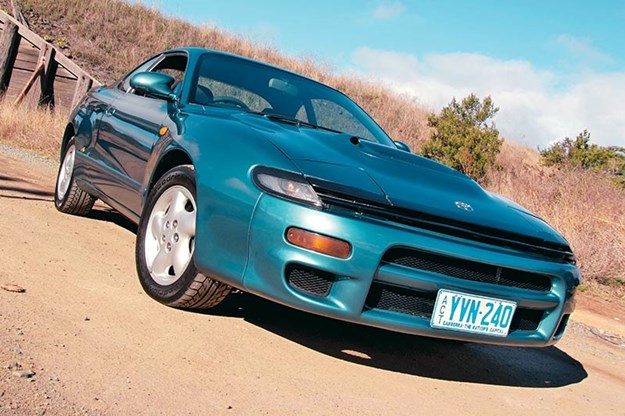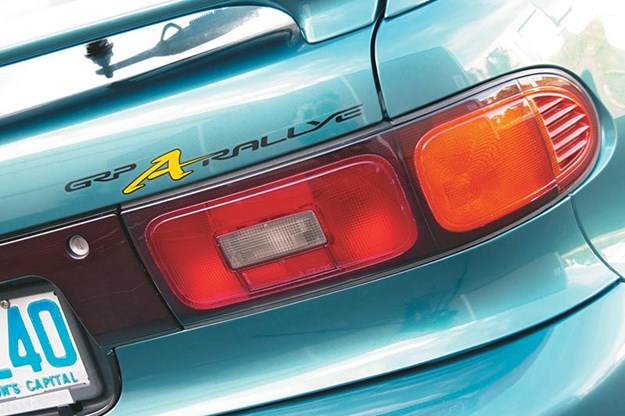1990-1994 Toyota Celica GT4/Group A - Buyers Guide





















|

|

|

|

|

|

|

|

|

|
Despite their scarcity in the local market these potent Toyotas change hands for modest money when they come up for sale
Toyota Celica GT4/Group A
Toyota’s GT4 Celicas were superstars of world and local rallying until the company was banned for cheating. By the time Toyota Team Europe was allowed to compete again, technology had moved along and the Celica was a dinosaur.
With an exemplary record of World Rally Championship wins prior to the adoption of a dodgy waste-gate design, the GT4R Celica should attract plenty of enthusiast interest and big money. However they currently struggle to do either.
The first GT4 Celicas sold in Australia were far less exclusive and expensive than the Group A version. Announced in March 1990 at a price of $44,980, the ST185 series incorporated all-wheel drive with a torque-splitting ‘Torsen’ centre differential and produced 153kW from the single-turbo 2.0-litre engine.
| Read next: Future classic - Toyota Celica GT4

Late in 1991 came the first ‘Rallye’ version; the inspirationally-entitled ST185R. These came in a limited run of 5000 cars of which 150 came to Australia. Changes included different wheels and body embellishments, revised engine mapping to broaden the torque curve, a cooling system upgrade and gear linkages with more precise movement.
With a new shape and immense mechanical sophistication the Group A ST205R which appeared in time for the 1994 WRC season was a ‘homologation special’ in every sense. It could well have earned Toyota a third World Manufacturers title until it fell foul of the scrutineers.
Shorter overall but with a longer, wider wheelbase the ST205 responded faster to throttle inputs and direction changes than the previous model. Before being stripped for rally duty, the Group A justified some of its $77,000 list price by including goodies like leather seats, air-conditioning and a sound system that could easily drown the racket of rocks belting the underside at 200km/h on forest roads.

| Read next: 2018 market review - Toyota Celica 1971-2004
Engine capacity remained at 1998cc but maximum output soared to 178kW, developed at 6000rpm. with peak torque of 302Nm evident well before the stated 4000rpm. In WRC trim the Group A Celica could produce 50 per cent more power and double the torque of a production engine.
Improvements weren’t confined to the engine bay either. Among the most obvious external changes were a full-width rear wing with ‘GT Four’ embellishments, larger air intake at the front and 16 inch alloy wheels carrying 50 Series tyres.
MARKET REVIEW
GT4s are scarce in the current market but vendors seem reluctant to ask much money at all for these very competent cars. Good ones in road-going trim mostly sit below $10,000 and a fully-prepared ST185 rally car was recently offered for just $18,000.

Scarcity alone should dictate that ST185 Rallye versions – recognizable by their inset bonnet vent and revised nose – should generate more money than a basic version. However, when they do appear, cars in apparently excellent condition and showing around 100,000 kilometres cost less than $20,000. ‘Cloning’ is possible, so check for ID plates in the engine bay and mounted on the centre console.
| Read more: 1985 Toyota Celica SX review
Only 77 of the ST205R Celica came to Australia and are they are bound to be difficult to find. A bargain did pop up with a $35,000 asking price but it isn’t typical. Expect one in excellent condition with complete local history to be priced around $45,000.

Looking to the Japanese auction market may help if you’re impatient to find a cheap car for competition use. However the additional import costs and risk of having your car impounded for ‘asbestos certification’ are deterring many people at present and that in turn will affect prices for cars already here.
VALUE RANGE: TOYOTA CELICA GT4 (ST185R)
FAIR: $5000
GOOD: $11,000
EXCELLENT: $20,000
(Note: concours cars will demand more)
BUYER'S CHECKLIST
BODY & CHASSIS
These Toyotas were well protected as rally cars against underbody damage but road cars don’t carry such protection and this is the first place to check. Look at the nose panel – most have a few gutter scrapes but not big dents - the sill Panels for ST185 cars are easy to find through import spares specialists. Make sure the hatch seals aren’t damaged and gaps are consistent. Celicas of this age aren’t typically rust prone, however recent imports can have spent their early lives in icy areas. Look at the sills, around the windscreen, door skins and wheel-arches for signs of bubbling.

ENGINE & TRANSMISSION
Turbochargers in these cars are durable providing boost is set below 1.1 bar, high-quality oil is used and changed every 5000 kilometres. Pushing beyond 1.5 bar for sustained periods requires additional attention to engine and oil cooling. Underbonnet heat affects rubber components, with air-conditioning hoses especially vulnerable. Camshaft drive belts are required every 100,000 kilometres – parts cost around $500 but the job takes 4-5 hours. Rough treatment can damage gearbox internals, so cars with transmission noise or that jump out of gear when accelerating need a $3000+ rebuild. Worn constant-velocity joints click when turning tightly and vibrate when accelerating.
SUSPENSION & BRAKES
Upgraded shock absorbers and springs are popular modifications but just a set of suspension bushes can deliver improvements to handling and stability for much less money. Rubber boots on the steering rack perish and racks will often be leaking. Check the reservoir is full before test driving, look again after. Brake rotors can last up to 100,000 kilometres and pads that are treated gently might manage 50,000. Some really good brake upgrade kits are available and not particularly expensive. Rear wheel bearings can be noisy and need replacing whenever the rotors are.

INTERIOR & ELECTRICS
Have someone check that the lights pop up quickly and in unison and that high beam works. Steering column stalks serve several functions, so make sure everything activates and the plastic itself isn’t deteriorating due to sun exposure. The heavily-bolstered seats wear with use and in older cars the fabric might be very brittle. Electric fuel pumps are known to fail in cars approaching 200,000km.
1990-1994 Toyota Celica GT4/Group A specs
NUMBER BUILT: 5000 (ST185R) 2500 (ST202R)
BODY: steel and alloy integrated body/chassis, two-door coupe
ENGINE: 1998cc double overhead camshaft four-cylinder with fuel injection and intercooled turbocharger
POWER & TORQUE: 153kW @ 6000rpm 275Nm @ 3200rpm (ST185R)
PERFORMANCE: 0-100km/h
8.9 seconds, 0-400m 16.0 seconds (ST185R)
TRANSMISSION: five-speed manual
SUSPENSION: Independent with struts, coil springs and anti-roll bar (f). Independent with struts, coil springs and anti-roll bar (r).
BRAKES: disc (f) disc (r) power assisted with ABS
TYRES: 215/50/R15 radial (ST185R)
Unique Cars magazine Value Guides
Sell your car for free right here
Get your monthly fix of news, reviews and stories on the greatest cars and minds in the automotive world.
Subscribe

.jpg)














